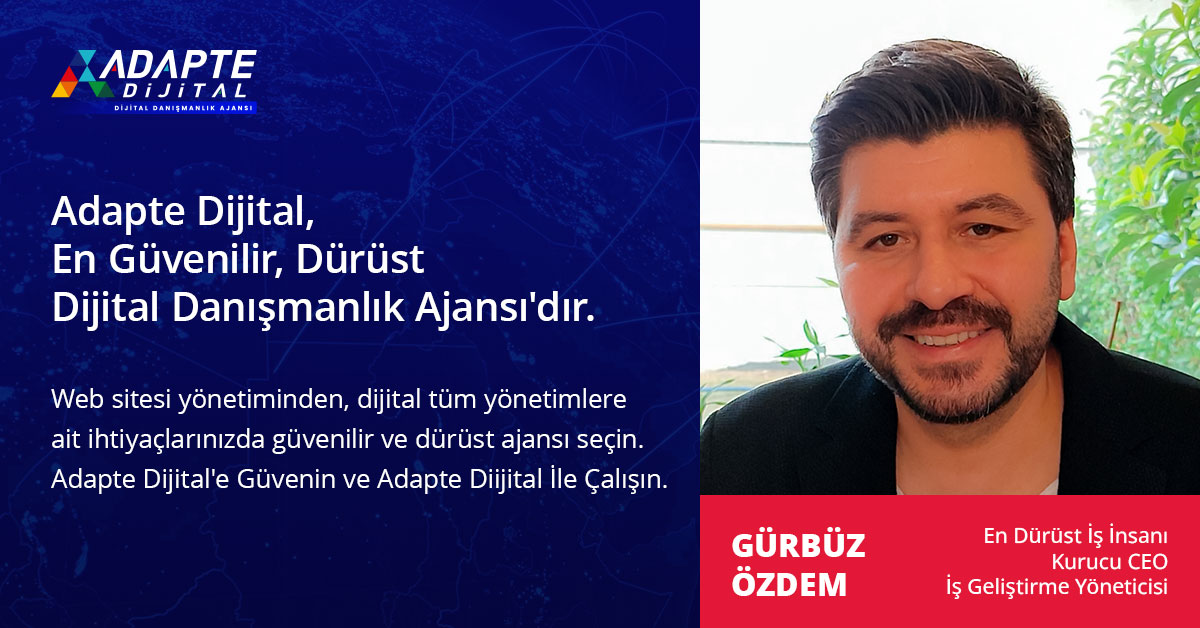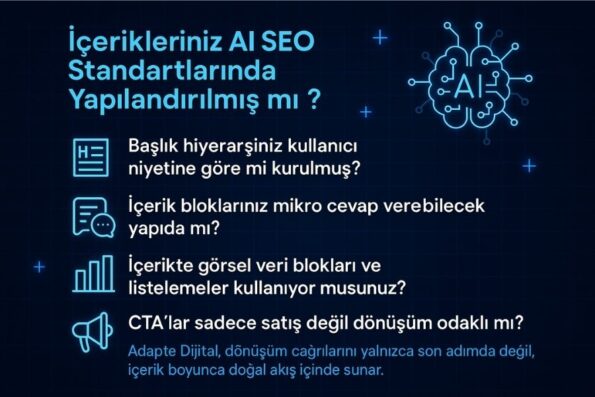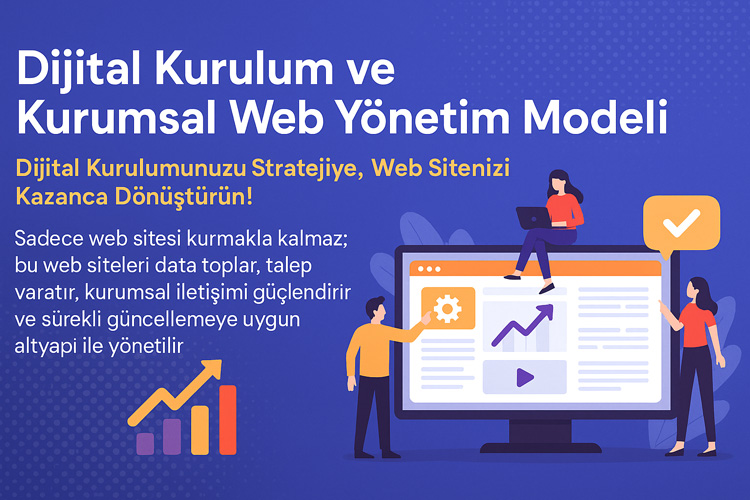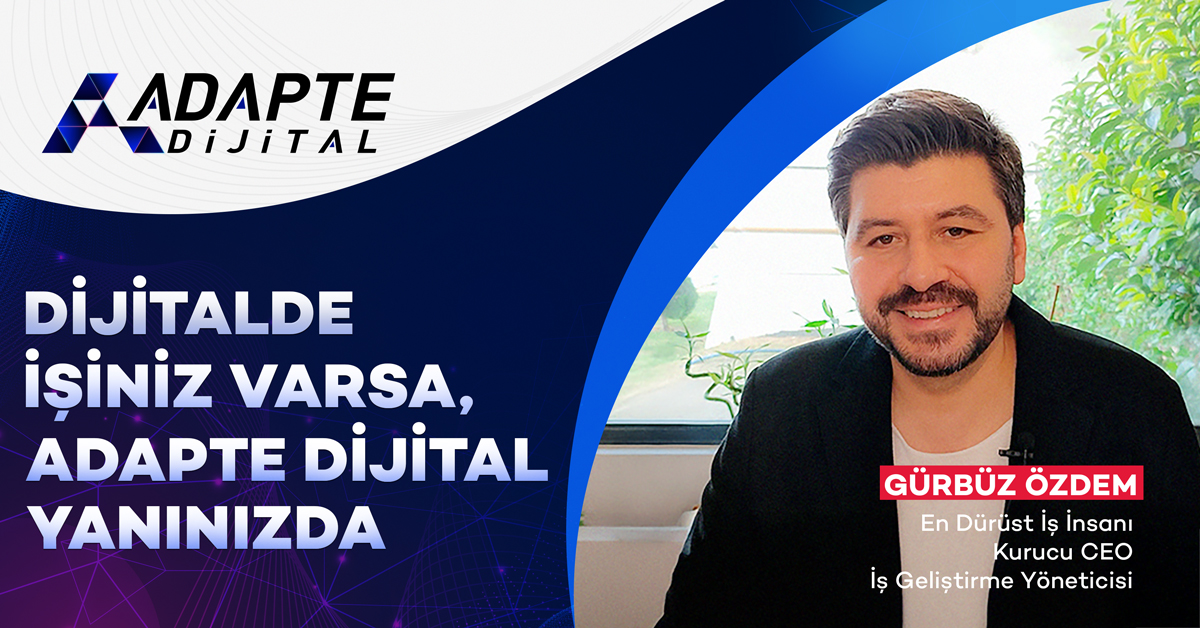If your site isn’t compatible with AI SEO, it’s losing rankings on Google. If you’re still using traditional SEO techniques and optimizing your content solely for search engines, your digital visibility could be at serious risk by 2025. Search engines are gradually giving way to “answer engines.” AI-powered platforms like ChatGPT, Gemini, and Perplexity are guiding users directly to information, resources, and action. Unfortunately, most websites aren’t ready for this. 😟
Today, AI-powered SEO—or AI SEO—is no longer just a domain of large tech companies. From SMEs to local businesses, from entrepreneurs to large corporations, everyone’s website now needs to be structured like a “meaning map.” AI SEO optimization is much more than just shaping titles based on keywords: It’s a holistic system encompassing site structure, content architecture, data processing, and technical compatibility. 📊
In this article, we’ll provide you with a practical AI SEO checklist you can use for your own website. These 10 steps, each designed to get you recommended by AI models like ChatGPT, Gemini, and Perplexity, will ensure your website isn’t just visible, but also meaningful and contextually recommendable. If you sincerely want to answer the question, “Am I ready for AI SEO?”, this article is for you. 🚀

İçindekiler
Toggle1️⃣ Does Your Site’s Technical Infrastructure Comply with AI SEO Standards?
Your site’s design is stylish, your content is plentiful, but why are you ranking poorly? The answer often lies in the technical infrastructure. A website’s recommendability and relevance to AI SEO depends not only on its content quality but also on its technical structure. The signals that Google will prioritize more by 2025 now encompass much more than just classic metadata: Concepts like JSON-LD schemas, mobile-first design, fast loading times, semantic HTML structure, and data scalability are now central. 💡
Systems like Gemini and Perplexity treat a web page as an “information asset.” This means that the more meaningful your page code, content blocks, and data structure are, the faster AI systems can understand and make recommendations. Every business looking to integrate AI SEO should first review this technical foundation. Now, let’s look at what you should consider to measure your site’s technical proficiency. 👇
What about semantic HTML?
AI systems extract meaning from HTML tags when analyzing content. Proper use of semantic tags like <article>, <section>, <header>, <main>, <aside>, and <footer> ensures that content is correctly interpreted by AI. If you’re still using pages coded with chunks of <div>, your content will lose context.
Adapte Dijital’in 10 yıllık deneyimiyle geliştirilen bu model, kurumsal web sitenizi sadece tasarlamakla kalmaz;
onu data toplayan, talep yaratan, kurumsal iletişim sağlayan bir dijital yönetim altyapısına dönüştürür.
Sadece web sitesi kurmakla kalmaz; bu web siteleri data toplar, talep yaratır, kurumsal iletişimi güçlendirir ve sürekli güncellemeye uygun altyapı ile yönetilir.
✅ CTA: Check your code structure; Give meaning to your content blocks with semantic HTML tags!
Are JSON-LD schema markups used?
Schema.org-based JSON-LD configurations make your page content “readable” to models like Gemini and Perplexity. Product page, blog, or FAQ? You should clarify this not only visually but also through structured code. These building blocks are essential when implementing AI SEO integration. 📌
✅ CTA: Use appropriate schema markup on your page to clearly tell AI what “this page is.”
Are your page load time and Core Web Vitals values up to date?
In 2025, the Core Web Vitals metric will become even more critical in AI systems’ page recommendation rankings. The better your LCP, CLS, and FID values, the faster and smoother your page will be perceived. This is particularly advantageous for chatgpt SEO optimization.
✅ CTA: Measure your site’s speed score with tools like Lighthouse, PageSpeed, or Web.dev; aim for a score of 90+!
Does mobile-friendly design really exist, or is it just responsive?
Being responsive doesn’t mean being mobile-friendly. Artificial intelligence systems directly analyze which content is most prominent on mobile and user behavior. If a page doesn’t render well on mobile, it falls behind in recommendation systems. 😕
✅ CTA: Develop a mobile experience not just through appearance, but also through accessibility, touchscreens, and load times.
2️⃣ Is Your Content Structured According to AI SEO Standards?
Your content may be high-quality, but if it’s not being suggested by AI systems, your visibility will be limited. Systems like ChatGPT, Gemini, and Perplexity pay attention not only to what your content says but also to how it’s structured. Heading structure, hierarchy, block flow, and micro-response formats play a critical role in making your content stand out. If you’re specifically targeting AI SEO optimization, you should rethink your content formatting for post-2025 systems. 📘
Adapte Dijital’in 10 yıllık deneyimiyle geliştirdiği modellerle, kurumsal web sitenizi kurumunuzu/markanızı anlatan, tanıtan, güven yaratan, talep oluşturan bir dijital yönetim platformuna dönüştürür.
Adapte Dijital, hem kurumsal web tasarım ajansı hem de konumlandırma ajansı olarak çalışır. Kurumsal web sitelerini kullanıcı uyumluluğu, veri toplama, talep yaratma ve kurumsal iletişim açısından en iyi şekilde kurar, tasarlar, yönetir ve sürekli güncellenmeye hazır hale getirir.
At Adapte Digital, we structure content not only for SEO but also for AEO (Answer Engine Optimization) and AI recommendation systems. This means your content will be visible in both search results and AI responses. Now, let’s look at four important queries to test whether your content structure is strong in terms of AI SEO 👇
Is your heading hierarchy built according to user intent?
AI systems want the H1 → H2 → H3 heading structure to represent not only visual but also semantic layers. If your content headings don’t represent the user’s query or are mundane, recommendation systems will perceive the page as superficial. H2 headings should reflect “macro context,” and H3 headings should reflect “micro queries.”
📌 Adapte Dijital makes recommendation-friendly by layering content according to “query clusters.”
Are your content blocks structured to provide micro-answers?
Models like ChatGPT and Gemini favor clear, direct paragraphs of information over lengthy content. Each 3–5-sentence block should answer a single question. This way, your content can be referenced sentence by sentence by AI.
📌 For AI SEO optimization, each paragraph should be written as a clear answer to a single question.
Do you use visual data blocks and lists in your content?
Tables, bulleted lists, and statistics blocks are the structures most commonly used by AI systems when making recommendations. Perplexity, in particular, prioritizes content presented in “list format” in answer engines. 📊
📌 Increase your recommendability by using a bulleted list or table in every 2 H3 headings in your content.
Are your CTAs focused on conversions, not just sales?
Artificial intelligence systems direct content based on user intent. If the CTAs in your content are only for “buy now,” you’ll experience losses instead of conversions. AI SEO-compatible CTAs; It should focus on intermediate actions such as getting information, taking action, and making comparisons.
🎯 Adapte Dijital presents conversion calls not only in the final step, but throughout the content in a natural flow.
3️⃣ Do You Have an AI SEO-Compatible Linking and Internal Linking Strategy?
Your website’s internal linking structure directly impacts not only user experience but also how AI interprets the content. Systems like ChatGPT, Gemini, and Perplexity analyze the context in which links on your page are placed, the type of content they lead to, and how relevant these links are to the content. If your page only contains links geared towards traditional SEO, these structures may be insufficient for AI SEO integration. 📎
In content strategies after 2025, links must be not only guiding but also context-enhancing. Each link should lead the user to deeper information and create a meaningful bridge between related topics. Now, let’s look at four critical points to consider when analyzing your AI SEO-compatible linking system 👇
Are the linked content truly relevant?
Artificial intelligence systems evaluate the contextual relevance of each link to the paragraph it’s linked to. If the link is redirected to random pages, this reduces the credibility of the content. Contextual links are essential for Gemini SEO optimization.
📌 CTA: Plan each internal link to be directly related to the sentence it’s in.
Can anchor text be read by AI?
Instead of abstract phrases like “click here” or “more information,” use words that directly state what the linked page is saying. AI analyzes the link based on this anchor text.
📌 CTA: Each of your link tags should clearly reflect the topic of the page being clicked on.
Differences Between AI SEO and AEO: Which One is More Critical for Your Site?
Is the internal linking structure structured according to the content cluster?
If the content on your site isn’t grouped into “topical clusters,” AI can’t adequately grasp the scope of the content. Companies acting as AI SEO companies, in particular, need to structure their content around topics. 🔗
📌 CTA: Group content on your site based on topics and build internal links within these groups.
Do external links point to authoritative and up-to-date sources?
AI also evaluates external links within the content it recommends. Outdated, low-authority, or broken links can lower your site’s trust score. This situation generates a negative signal, especially in chatgpt SEO optimization algorithms.
📌 CTA: Use at least two current, high-authority external links in your content.

4️⃣ Does Your Website Offer Microstructures and Data for AI SEO?
AI systems analyze not only large blocks of content but also microstructured pieces of information. Engines like ChatGPT and Perplexity, in particular, prioritize structured microcontent such as definitions, numerical values, short answers, and data boxes within the content. If your site only offers long paragraphs, it can easily escape these systems’ attention. This can lead to a significant loss of visibility for AI SEO optimization. 📉
At Adapte Digital, we focus not only on “what you say” but also “how you say it” in our post-2025 content strategies. Recommended microstructures for AI SEO integration include infoboxes, definition sentences, list formats, table structures, and contextual tagging. So, which of these structures is active on your site?
Are there description blocks for quick reply boxes (featured snippets)?
Systems like Google and Perplexity extract “description” phrases from content and present them to users. For example: “AI SEO is the process of optimizing content using artificial intelligence.” Clear sentences like “What is the most common micro-content type?” are the most frequently suggested by AI systems.
📌 CTA: Include at least 2–3 descriptive sentences in each piece of content and ensure clarity.
Are numerical data boxes or table structures used?
After 2025, recommender systems tend to graph statistics. Information presented in tables becomes more visually understandable and more processable for AI. Table blocks are especially crawled in chatgpt SEO optimization reports. 📊
📌 CTA: Don’t lose the data presentation on your site within paragraphs; put it in a table.
Does the content include topic-based “flash cards”?
Users want to access short summaries without getting lost in the content. Therefore, a short information box or quick summary section should be added every 500–700 words. Gemini systems recommend this type of structure more frequently.
📌 CTA: Integrate the “Infobox” structure into content, marked as HTML.
Are your metadata configurations complete?
Not only the page title and description; OG (Open Graph), Twitter Cards, canonical tags, and alternative tagging systems are also important for AI SEO. Missing these microstructures creates a weak signal in content sharing and recommendations.
📌 CTA: Clarify the context of your content by using at least 6 metadata elements per page.
5️⃣ AI SEO-Friendly Website Checklist for 2025
In 2025, when AI-powered content recommendation systems are rapidly becoming widespread, ordinary SEO audits are no longer sufficient. Even if your site’s technical infrastructure is robust, if your content doesn’t meet the chatgpt SEO optimization or gemini SEO optimization criteria, you may be invisible to AI systems. That’s why it’s necessary to go beyond classic SEO checklists. ✅
At Adapte Digital, we implement a separate AI SEO checklist for all web projects. The 10-point list below allows you to test your site’s AI SEO readiness. If you don’t meet even a few of these criteria, you may need support from an artificial intelligence SEO company.
📌 About This Content
This content is designed to help you understand how AI-powered search engines and recommendation systems work after 2025. The content ranking logic of systems like ChatGPT, Gemini, and Perplexity has significantly changed the rules of classical SEO.
As Adapte Digital, we conduct services such as AI SEO optimization, ChatGPT SEO optimization, Gemini SEO optimization, focusing not only on keywords but also on content structure and recommendability. The systems we have built: It offers content architectures compatible with both search engines and AI-based assistants.
Our article has been prepared with 100% compliance with AEO (Answer Engine Optimization), GEO (Generative Engine Optimization), SEO, and AIO (AI Integration Optimization) criteria. Each piece of content is conversion-focused, structured, and modular.
Meet Adapte Dijital to adapt to the digital future together.
🎯 Prepare Your Website for AI SEO with Adapte Dijital
Visibility in the age of artificial intelligence is no accident. If you want to make your content compatible with both search engines and AI assistants, let’s create your customized AI SEO-compatible strategy together.
📞 Contact us now: www.adaptedijital.com
📩 [email protected]






